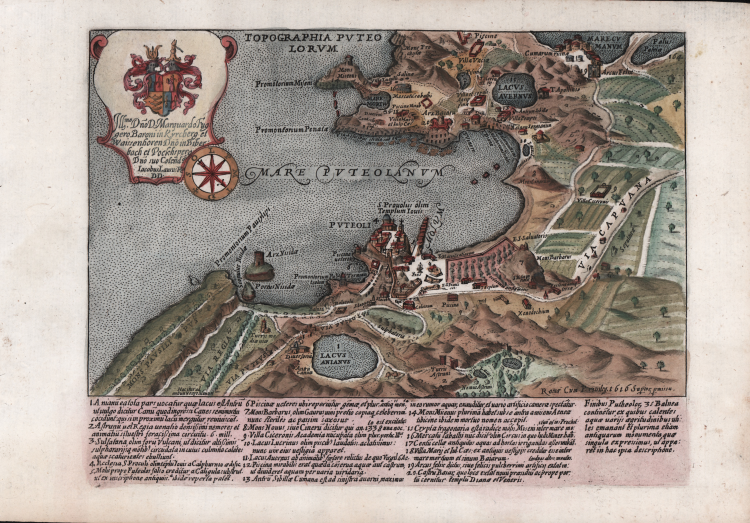



| Reference: | S20266 |
| Author | Giacomo LAURO |
| Year: | 1616 |
| Zone: | Campi Flegrei |
| Printed: | Rome |
| Measures: | 235 x 180 mm |


| Reference: | S20266 |
| Author | Giacomo LAURO |
| Year: | 1616 |
| Zone: | Campi Flegrei |
| Printed: | Rome |
| Measures: | 235 x 180 mm |
Map of Pozzuoli taken from Giacomo Lauro's most famous work "Antiquae urbis splendor " published for the first time in 1612/15 in 3 parts, and then increased in 1628 by a fourth part.
The last part, edited by Jan Alten, contains views of the villas in and around Rome. The work was later reprinted, given the great success, by Rudolf Alten.
That Pozzuoli map derives from the model introduced by Mario Cartaro in 1577.
Plate taken from the important Antiquae urbis splendor by Giacomo Lauro. The full title is: Antiquae urbis splendor, hoc est praecipua eiusdum templa, amphitheatra, theatra, circi, naumachie, arcus triumphales, mausolea aliaque sumptuosiora aedificia, pompae item triumphalis et colossaearum imaginum descriptio; opera & industria Iacobi Lauri Romani in aes incisa atque in lucem edita. Addita est breuis quaedam et succincta imaginum explicatio in qua regum consulum imperatoruq; res gestae et rei romanae origo progressus incrementum, ac finis cu almae urbis antiquor. ac modernor. vestigior. additione utcunq; hoc insequenti anno 1630 reperiutur, et ex veteru ac recentior. historiar. monumentis clare ostenditur.
The book has a long and varied history of publishing, beginning in 1612, though Lauro’s work on the book predates its publishing by at least eighteen years. The book was first printed by Giacomo Mascardi, and it originally only contained two parts, though by 1615 it had expanded to a third part. The first part contained 37 engravings, with a dedication to King Sigismund III of Poland, dated 1614, and a portrait dated 1609 (borrowed from another book of engravings). The second part contained a portrait of Charles Emmanuel I, Duke of Savoy, dated 1613, and 41 engravings. It is worth noting that these first two books were both dedicated to Polish nobility, probably due to the fact that Lauro had enjoyed patronage from engraving Polish battles early in his career. The third part, added later, was dedicated to Ranuccio Farnese, one of Lauro’s greater patrons later in his life, and contained 40 engravings.
The number of plates included in each of the earlier editions of Lauro’s work (printed at the Camera Apostolica in 1614 in four parts, and printed there again in 1621 in three parts) was finally settled in 1628 with the addition of the fourth and final book for a total of 166 engravings, which is the generally accepted number for how many engravings total Lauro produced for this work. The edition published by Vitale Mascardi and curated by Giovanni Alto was released in 1637. Alto added a final index and numbered each of the engravings, 2-167, for this latest release.
Copperplate, printed on contemporary laid paper and with fine hand colouring, good condition.
|
Engraver, printer and print publisher. Active in Rome from 1583. 17 March 1598 he applied for and was granted a ten-year papal privilege for an unspecified number of unnamed religious prints.
Lauro’s earliest dated prints are of 1585, and carry the address of C. Duchetti. He also worked for Panzera in 1589. From 1590 he tried to establish himself as a publisher of his own work. He acquired and restored old plates, published copies of such classic prints as Marcantonio’ St.Paul preaching . He accepted commissions, as the map of Rocca Contrada, 1594.
He probably acquired plates from Jacob Matham which he published in 1598. His Antiquae Urbis Splendor was published in parts from 1612. In the volumes issued in 1614 and 1615 Lauro refers to having worked on it for 28 years which would mean that he began it about 1586. Important connections with Poland; he specialized in images of saints.
|
|
Engraver, printer and print publisher. Active in Rome from 1583. 17 March 1598 he applied for and was granted a ten-year papal privilege for an unspecified number of unnamed religious prints.
Lauro’s earliest dated prints are of 1585, and carry the address of C. Duchetti. He also worked for Panzera in 1589. From 1590 he tried to establish himself as a publisher of his own work. He acquired and restored old plates, published copies of such classic prints as Marcantonio’ St.Paul preaching . He accepted commissions, as the map of Rocca Contrada, 1594.
He probably acquired plates from Jacob Matham which he published in 1598. His Antiquae Urbis Splendor was published in parts from 1612. In the volumes issued in 1614 and 1615 Lauro refers to having worked on it for 28 years which would mean that he began it about 1586. Important connections with Poland; he specialized in images of saints.
|